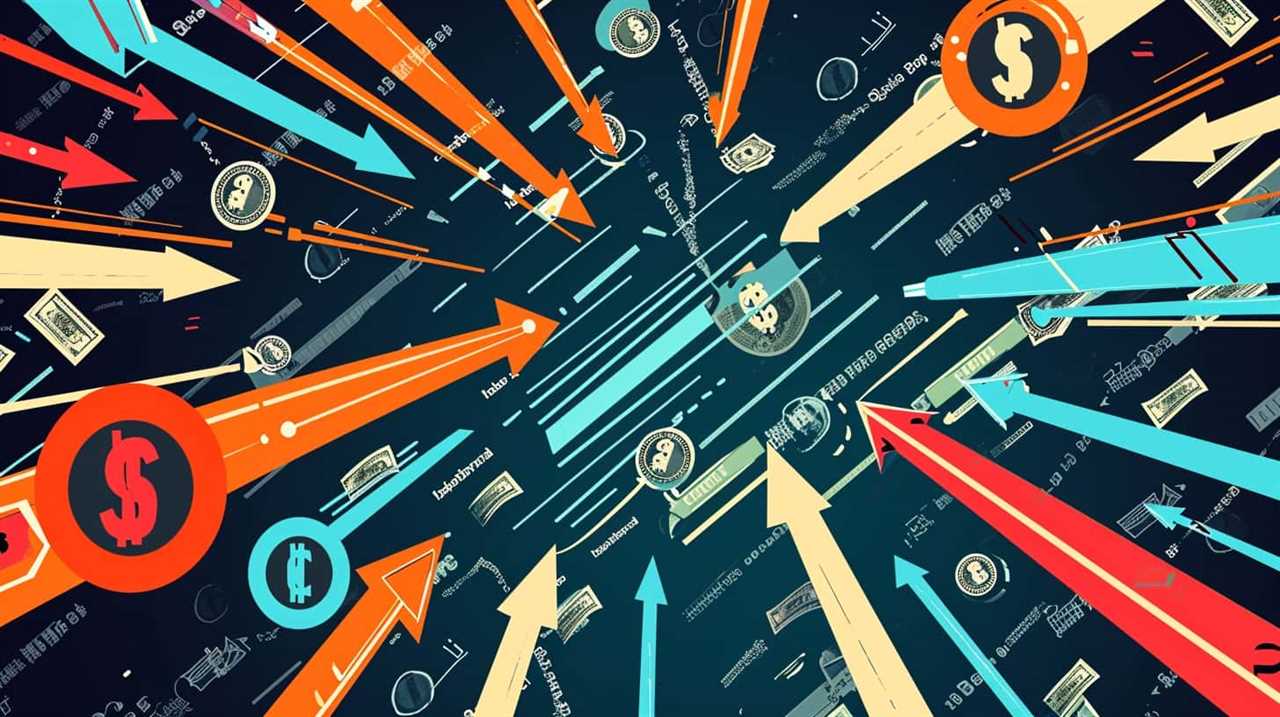By chance, we discovered 10 amazing insights into Friedman’s groundbreaking theory of controlling money supply. Come with us as we explore the revolutionary ideas that have influenced the field of economics.
Monetarism, as explained by Friedman, offers a fresh perspective on the role of central banks and the relationship between inflation and money supply.
Through our exploration, we will uncover the impact of money supply on the economy and the enduring influence Friedman has had on monetary policy.
Engage in the ongoing debate surrounding money supply control and gain a deeper understanding of the relevance of Friedman’s theory in today’s innovative landscape.

Get ready to embark on a journey of intellectual discovery and unlock the secrets of Friedman’s extraordinary ideas.
Key Takeaways
- Monetarism advocates for controlling the money supply, with Friedman believing that fluctuations in the money supply impact economic activity.
- Friedman believed that stable and predictable growth in the money supply is crucial for economic stability and prosperity, as it helps maintain stable prices and influences aggregate demand, interest rates, investment, and consumption.
- Central banks play a pivotal role in managing the money supply, as they can influence interest rates, act as lenders of last resort during financial distress, and regulate and supervise financial institutions.
- The quantity theory of money explains the relationship between inflation and money supply, with Friedman’s theory stating that controlling the money supply can control inflation. However, there are criticisms of this theory, such as oversimplification of the impact of money supply on economic outcomes and the influence of other factors on economic growth and inflation, as well as the fluctuation of the velocity of money. Keynesian economics emphasizes government intervention through fiscal policy as an alternative approach to managing inflation and stimulating economic activity.
Monetarism Explained
Our understanding of monetarism is deepened by examining Friedman’s theory of money supply control. Monetarism, a school of thought in economics, advocates for controlling the money supply as a means to stabilize the economy and control inflation. This theory suggests that the central bank should focus on controlling the growth rate of the money supply to achieve stable economic growth.
Friedman’s theory of money supply control has significant monetary policy implications. According to Friedman, changes in the money supply have a direct impact on aggregate demand and, consequently, on the overall level of economic activity. By controlling the growth rate of the money supply, the central bank can influence interest rates and, in turn, stimulate or slow down economic activity.
However, monetarism hasn’t been without its critics. One of the main critiques of monetarism is the difficulty in accurately measuring and predicting the demand for money. Critics argue that the relationship between the money supply and economic activity isn’t as straightforward as monetarists claim, and that other factors, such as fiscal policy, also play a significant role.

Friedman’s View on Money Supply
When examining Friedman’s view on money supply, it becomes evident that he believed it to be of utmost importance in understanding and controlling economic fluctuations.
According to Friedman, fluctuations in the money supply directly impact economic activity, employment rates, and overall price levels.
This perspective led him to advocate for policies that prioritize stable and predictable growth in the money supply, as he believed it to be a key driver of economic stability and prosperity.
Money Supply Importance
Friedman emphasizes the crucial role of money supply in driving economic growth and stability. Understanding the importance of money supply dynamics and effective money supply management is essential for achieving sustainable economic development. Here are five key points that highlight the significance of money supply:

- Price stability: Appropriate management of money supply helps maintain stable prices, preventing inflation or deflationary pressures.
- Aggregate demand management: By controlling money supply, policymakers can influence aggregate demand and stabilize the economy during periods of expansion or contraction.
- Interest rates: Money supply affects interest rates, which in turn impact investment, consumption, and overall economic activity.
- Financial stability: Proper management of money supply can mitigate risks in the financial system, reducing the likelihood of financial crises.
- Monetary policy effectiveness: A well-managed money supply enhances the effectiveness of monetary policy in achieving macroeconomic objectives.
Understanding the importance of money supply is crucial for policymakers, economists, and businesses seeking innovative solutions for sustainable economic growth.
Friedman’s Policy Implications
In our analysis of Friedman’s money supply control theory, we will now explore the policy implications and views on money supply. Friedman’s policy implications revolve around the idea that controlling inflation can be achieved through the manipulation of the money supply. By increasing or decreasing the amount of money in circulation, central banks can influence interest rates and ultimately stabilize the economy. In his view, excessive growth in the money supply leads to inflation, while a decrease in the money supply can help combat inflationary pressures. To illustrate this concept, let’s take a look at the following table:
| Policy Implication | Effects |
|---|---|
| Increase in money supply | Higher inflation rates |
| Decrease in money supply | Lower inflation rates |
Understanding these policy implications is crucial for central banks as they play a pivotal role in managing the money supply and maintaining economic stability. In the subsequent section, we will delve into the role of central banks in implementing these policies.
The Role of Central Banks
Central banks play a crucial role in controlling the money supply. Their actions and policies have a significant impact on the economy and financial markets. Here are five key aspects that highlight the importance of central banks in this regard:

- Central Bank Independence: Central banks are typically granted a high degree of independence from political interference. This independence allows them to make decisions based on economic objectives rather than short-term political considerations. It ensures that monetary policy is implemented in a consistent and credible manner.
- Role of Interest Rates: Central banks use interest rates as a tool to influence the money supply. By adjusting interest rates, they can encourage or discourage borrowing and spending, thereby affecting the overall level of economic activity. Lower interest rates can stimulate borrowing and investment, while higher rates can curb inflationary pressures.
- Lender of Last Resort: Central banks act as lenders of last resort, providing emergency liquidity to financial institutions during times of financial distress. This helps maintain stability in the financial system and prevents widespread panic or bank runs.
- Regulation and Supervision: Central banks also play a critical role in regulating and supervising financial institutions. They set and enforce prudential regulations to ensure the safety and soundness of the banking system, reducing the risk of financial crises.
- Currency Issuance: Central banks have the authority to issue and control the nation’s currency. By managing the supply of money in circulation, they can influence inflation and maintain the stability of the currency.
Quantity Theory of Money
The Quantity Theory of Money provides a fundamental understanding of the relationship between the money supply and the overall level of prices in an economy. This theory, often associated with monetarism, asserts that changes in the money supply have a direct impact on the level of prices. According to the quantity theory, if the money supply in an economy increases, the overall price level will also increase proportionally. Conversely, if the money supply decreases, the overall price level will decrease as well.
The quantity theory of money is based on the equation of exchange, which states that the total amount of money spent in an economy is equal to the total quantity of goods and services purchased (MV = PQ). In this equation, M represents the money supply, V represents the velocity of money (how quickly money circulates in the economy), P represents the price level, and Q represents the quantity of goods and services produced.
The quantity theory of money provides a framework for understanding the impact of changes in the money supply on inflation. By controlling the money supply, central banks can influence the overall level of prices in an economy.
In the next section, we’ll explore the relationship between inflation and the money supply in more detail.

Inflation and Money Supply Relationship
When examining the relationship between inflation and money supply, Friedman’s monetary policy theory provides valuable insights.
According to Friedman, an increase in the money supply leads to inflationary pressures in the economy.
This implies that controlling inflation can be achieved by controlling the money supply.
Friedman’s Monetary Policy
How does Friedman’s monetary policy theory explain the relationship between inflation and money supply? According to Friedman’s monetary theory, inflation is primarily caused by an excessive increase in the money supply. By controlling the money supply, central banks can influence inflation rates.

Here are five key insights into Friedman’s monetary policy implementation:
- Money supply growth should be kept stable and predictable to prevent inflationary pressures.
- Central banks should focus on controlling the money supply rather than targeting interest rates.
- Monetary policy should be rule-based, providing a clear framework for decision-making and avoiding discretionary actions.
- Friedman advocated for a constant growth rate of money supply, such as a fixed percentage increase each year.
- Friedman believed that monetary policy should be independent from political influence to maintain its effectiveness in controlling inflation.
Understanding these principles is crucial to comprehending the link between inflation and money supply in Friedman’s monetary theory. In the subsequent section, we’ll explore the specific inflationary pressures that can arise from changes in money supply.
Inflationary Pressures and Money Supply
In analyzing the relationship between inflation and money supply, we explore the dynamics of inflationary pressures resulting from changes in the money supply. The quantity theory of money, as proposed by economist Milton Friedman, asserts that changes in the money supply directly impact the level of inflation in an economy. When the money supply increases, inflationary pressures are often observed as more money chases the same amount of goods and services. Conversely, when the money supply decreases, deflationary pressures may arise. To illustrate this relationship, consider the following table:
| Money Supply (M) | Inflationary Pressures |
|---|---|
| Increase | Higher inflation |
| Decrease | Lower inflation |
| Stable | Stable inflation |
As seen in the table, changes in the money supply control can have a direct impact on inflationary pressures. Therefore, understanding and managing the money supply is crucial for controlling inflation in an economy.

Controlling Inflation Through Money Supply
To control inflation, we manage the money supply. Through various money supply control techniques and the implementation of inflation targeting, we can effectively curb inflationary pressures. Here are five key strategies:
- Open market operations: By buying or selling government securities, central banks can influence the money supply and adjust interest rates.
- Reserve requirements: Central banks can require commercial banks to hold a certain percentage of their deposits as reserves, limiting the amount of money available for lending.
- Discount rate: Adjusting the rate at which commercial banks can borrow from the central bank can impact the cost of borrowing and influence the money supply.
- Quantitative easing: In times of economic crisis, central banks may implement this unconventional policy to inject liquidity into the economy and stimulate growth.
- Forward guidance: Central banks can provide clear communication about their future monetary policy actions, helping to shape expectations and influence market behavior.
Criticisms of Friedman’s Theory
Despite some valid critiques, we find noteworthy insights into Friedman’s money supply control theory. While Friedman’s monetarism has been widely influential, it hasn’t been without its detractors. One of the main criticisms of Friedman’s theory is that it oversimplifies the relationship between money supply and economic outcomes. Critics argue that there are many other factors that influence economic growth and inflation, such as fiscal policy, technological advancements, and international trade. They contend that focusing solely on controlling the money supply ignores these important variables and may lead to ineffective policy decisions.
Another criticism of monetarism is that it assumes a stable relationship between money supply and economic activity, known as the velocity of money. However, empirical evidence has shown that the velocity of money isn’t constant and can fluctuate significantly over time. This challenges the central premise of Friedman’s theory and raises questions about its applicability in real-world scenarios.
Furthermore, alternative theories of money supply control, such as Keynesian economics, emphasize the role of aggregate demand in driving economic growth and inflation. They argue that government intervention through fiscal policy, such as increasing government spending or cutting taxes, can effectively stimulate economic activity and manage inflation.

Impact of Money Supply on the Economy
Overall, we frequently observe that changes in the money supply have a significant impact on the economy. The relationship between money supply and interest rates is a key driver of economic activity. Here are some key points to consider:
- Lowering the money supply can lead to higher interest rates, which can discourage borrowing and investment. This can slow down economic growth.
- Increasing the money supply can have the opposite effect, lowering interest rates and stimulating borrowing and investment. This can promote economic growth.
- Changes in the money supply can also affect inflation. An increase in the money supply can lead to higher inflation as there’s more money chasing the same amount of goods and services.
- Likewise, a decrease in the money supply can help control inflation by reducing the amount of money available for spending.
- The impact of money supply on the economy isn’t always immediate or linear. It can take time for changes in the money supply to fully manifest in the economy, and the relationship between money supply and economic growth can be influenced by various factors such as government policies, consumer behavior, and global economic conditions.
Understanding the relationship between money supply and the economy is crucial for policymakers and investors alike. By closely monitoring and analyzing changes in the money supply, we can gain valuable insights into the future direction of interest rates and economic growth.
Friedman’s Influence on Monetary Policy
Friedman’s influence on monetary policy has been significant and widely recognized. One of the key points to consider is the impact of his policy recommendations on the overall economy.
Friedman’s Policy Impact
We found Friedman’s influence on monetary policy to be significant. His ideas and theories have shaped the way policymakers approach monetary control and have had a lasting impact on economic policy. Here are five key ways in which Friedman’s policy impact can be seen:

- Emphasis on money supply control: Friedman argued that controlling the money supply is crucial for managing inflation and stabilizing the economy.
- Focus on monetary rules: He advocated for the use of clear and consistent monetary rules, such as targeting a specific growth rate for the money supply.
- Critique of discretionary policy: Friedman questioned the effectiveness of discretionary monetary policy, arguing that it can lead to destabilizing effects.
- Influence on central banks: His ideas have influenced the practices of central banks worldwide, shaping their approach to monetary policy.
- Continuing debate: Friedman’s ideas continue to be debated and analyzed, contributing to ongoing discussions on policy effectiveness and the role of monetary control.
Friedman’s policy impact has been instrumental in shaping monetary policy and continues to influence economic thinking and decision-making.
Monetary Control Effectiveness
Monetary control effectiveness is a key aspect of Friedman’s influence on monetary policy. In order to regulate the money supply, Friedman proposed using specific monetary control techniques.
One of these techniques is known as open market operations, where the central bank buys or sells government securities to influence the money supply.
Another technique is reserve requirements, which dictate the amount of reserves banks must hold in relation to their deposits.

Through these techniques, Friedman believed that the central bank could effectively control the money supply and stabilize the economy. However, the effectiveness of these techniques has been a subject of debate among economists.
Some argue that monetary policy can have limited impact on the overall economy, while others believe that it can play a crucial role in controlling inflation and promoting economic growth.
The Debate on Money Supply Control
Throughout the history of economic policy, there’s been ongoing debate regarding the control of money supply. This debate revolves around the effectiveness of monetary policy and the role of central banks in controlling the money supply.
To provide a deeper understanding of this topic, consider the following:

- Economic Stability: One argument in favor of controlling the money supply is that it helps maintain economic stability. By adjusting the money supply, central banks can influence interest rates, inflation, and economic growth.
- Inflation Risk: Critics of money supply control argue that excessive control can lead to inflation. They argue that central banks may not accurately predict the impact of their actions on the economy, resulting in unintended consequences.
- Market Efficiency: Proponents of money supply control contend that it enhances market efficiency. By managing the money supply, central banks can potentially prevent market distortions and promote a more stable financial system.
- Global Interdependencies: The debate on money supply control also takes into account global economic interdependencies. Central banks must consider how their actions may affect exchange rates, capital flows, and international trade.
- Technological Advances: With the advent of technological advancements and digital currencies, the debate on money supply control has become more complex. Central banks must grapple with how to regulate and control money supply in an increasingly digital and interconnected world.
Considering the ongoing debate on money supply control, it’s essential to examine the relevance of Friedman’s theory in today’s economic landscape.
Relevance of Friedman’s Theory Today
Friedman’s theory on money supply control remains highly relevant in today’s economic landscape. As we evaluate Friedman’s policy effectiveness, it’s clear that his theory continues to provide valuable insights for policymakers and economists alike.
One key aspect of Friedman’s theory that remains applicable today is the idea that controlling the money supply can have a significant impact on inflation and economic stability. This can be seen in practice through central banks’ use of monetary policy tools, such as adjusting interest rates or implementing quantitative easing measures, to influence the money supply and manage inflation.
Furthermore, Friedman’s theory emphasizes the importance of maintaining a stable and predictable monetary policy framework. This not only helps to anchor inflation expectations but also provides a solid foundation for business investment and economic growth. In today’s dynamic and interconnected global economy, having a clear and consistent monetary policy framework becomes even more crucial to ensure stability and foster innovation.

However, it’s important to note that Friedman’s theory isn’t without its critics. Some argue that the relationship between money supply and economic variables, such as inflation or output, may not be as strong as Friedman suggested. Additionally, the effectiveness of monetary policy in controlling inflation and stabilizing the economy has been challenged in recent years, particularly in the face of unconventional monetary policies and the limitations of interest rate adjustments.
Frequently Asked Questions
How Does Friedman’s Theory of Money Supply Control Relate to Other Economic Theories?
Friedman’s theory of money supply control, in comparison to Keynesian economics, focuses on the impact on inflation targeting. It emphasizes the importance of controlling the money supply to achieve stable prices and economic growth.
What Were Some of the Major Criticisms of Friedman’s Theory of Money Supply Control?
Critiques and limitations of Friedman’s money supply control theory include its assumption of stable velocity, lack of consideration for fiscal policy, and reliance on the accuracy of economic data.
How Did Friedman’s Views on Money Supply Control Influence Monetary Policy in Different Countries?
Friedman’s views on money supply control have had a significant influence on central banks worldwide. His theory emphasized the importance of controlling the money supply to effectively implement monetary policy and achieve economic stability.

What Are Some of the Key Factors That Determine the Relevance of Friedman’s Theory in Today’s Economic Landscape?
The relevance of Friedman’s theory in today’s economy lies in its application in monetary policy. Factors such as inflation, economic stability, and central bank independence determine its effectiveness and influence in shaping modern economic landscapes.
What Are Some of the Ongoing Debates Surrounding the Control of Money Supply and Its Impact on the Economy?
There are ongoing debates surrounding the impact of money supply control on the economy. We analyze these debates using analytical and data-driven approaches, focusing on the innovation and relevance of different perspectives.
What Insights Into Money Supply Control Theory Can Be Applied to Economic Theories Explaining Supply and Demand?
Understanding the best economic supply demand theories is crucial in gaining insights into money supply control theory. These theories help explain the intricate relationship between the quantity of money in circulation and its impact on supply and demand dynamics within the economy.
Conclusion
In conclusion, Friedman’s money supply control theory provides valuable insights into:
- The role of central banks
- The relationship between inflation and money supply
- The impact of money supply on the economy
His influence on monetary policy is undeniable, and the ongoing debate on money supply control continues to shape the field of economics.

Despite the passage of time, Friedman’s theory remains relevant today, reminding us of the importance of understanding and managing the money supply for a stable and prosperous economy.
Lauren’s talent in writing is matched by her passion for storytelling. Her love for books and deep understanding of culture and entertainment add a distinct flavor to her work. As our media and press contact, Lauren skillfully bridges the gap between afterQuotes and the broader media landscape, bringing our message to a wider audience.










